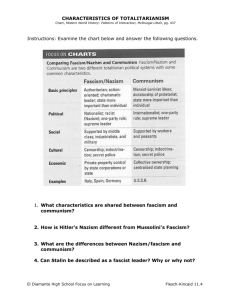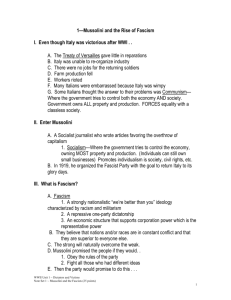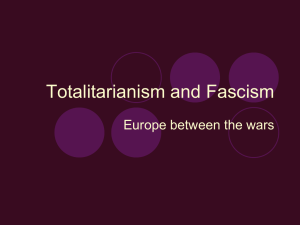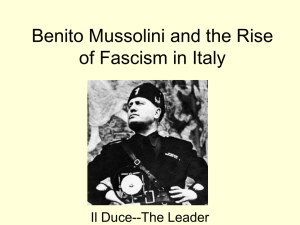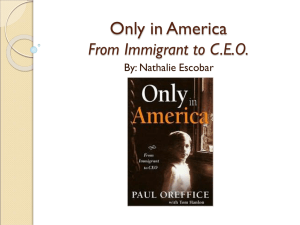Mussolini and the Rise of Fascism - history
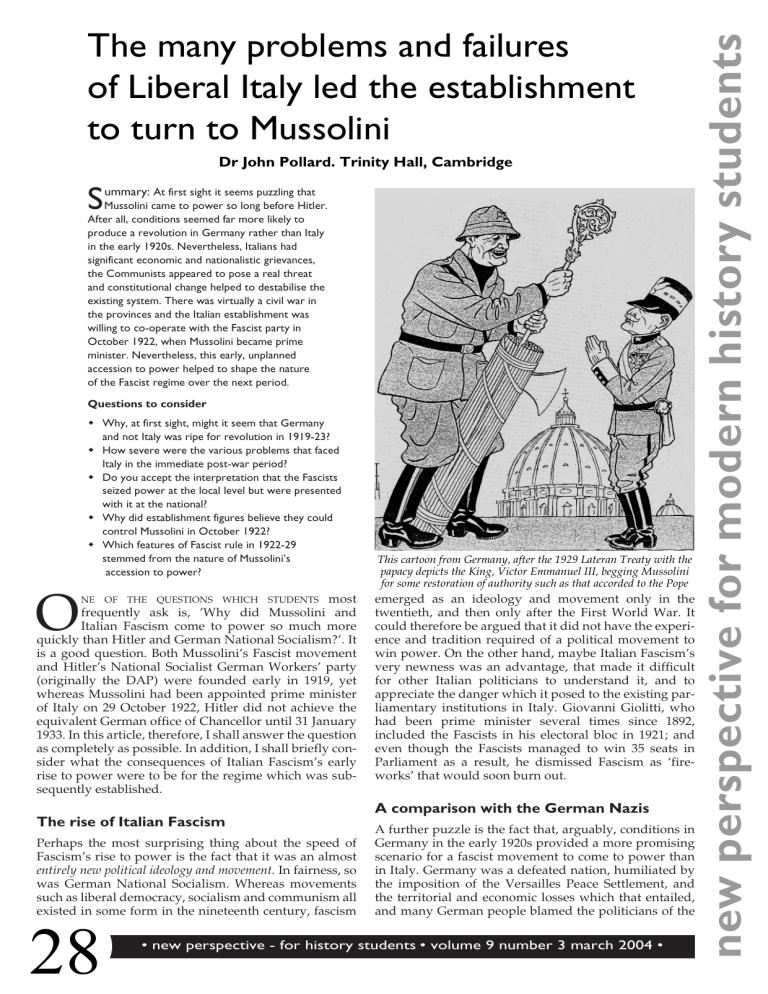
The many problems and failures of Liberal Italy led the establishment to turn to Mussolini
Dr John Pollard. Trinity Hall, Cambridge
S ummary: At first sight it seems puzzling that
Mussolini came to power so long before Hitler.
After all, conditions seemed far more likely to produce a revolution in Germany rather than Italy in the early 1920s. Nevertheless, Italians had significant economic and nationalistic grievances, the Communists appeared to pose a real threat and constitutional change helped to destabilise the existing system. There was virtually a civil war in the provinces and the Italian establishment was willing to co-operate with the Fascist party in
October 1922, when Mussolini became prime minister. Nevertheless, this early, unplanned accession to power helped to shape the nature of the Fascist regime over the next period.
Questions to consider
Why, at first sight, might it seem that Germany and not Italy was ripe for revolution in 1919-23?
How severe were the various problems that faced
Italy in the immediate post-war period?
Do you accept the interpretation that the Fascists seized power at the local level but were presented with it at the national?
Why did establishment figures believe they could control Mussolini in October 1922?
Which features of Fascist rule in 1922-29 stemmed from the nature of Mussolini’s accession to power?
O NE OF THE QUESTIONS WHICH STUDENTS most frequently ask is, ’Why did Mussolini and
Italian Fascism come to power so much more quickly than Hitler and German National Socialism?’. It is a good question. Both Mussolini’s Fascist movement and Hitler’s National Socialist German Workers’ party
(originally the DAP) were founded early in 1919, yet whereas Mussolini had been appointed prime minister of Italy on 29 October 1922, Hitler did not achieve the equivalent German office of Chancellor until 31 January
1933. In this article, therefore, I shall answer the question as completely as possible. In addition, I shall briefly consider what the consequences of Italian Fascism’s early rise to power were to be for the regime which was subsequently established.
This cartoon from Germany, after the 1929 Lateran Treaty with the papacy depicts the King, Victor Emmanuel III, begging Mussolini for some restoration of authority such as that accorded to the Pope emerged as an ideology and movement only in the twentieth, and then only after the First World War. It could therefore be argued that it did not have the experience and tradition required of a political movement to win power. On the other hand, maybe Italian Fascism’s very newness was an advantage, that made it difficult for other Italian politicians to understand it, and to appreciate the danger which it posed to the existing parliamentary institutions in Italy. Giovanni Giolitti, who had been prime minister several times since 1892, included the Fascists in his electoral bloc in 1921; and even though the Fascists managed to win 35 seats in
Parliament as a result, he dismissed Fascism as ‘fireworks’ that would soon burn out.
A comparison with the German Nazis
The rise of Italian Fascism
Perhaps the most surprising thing about the speed of
Fascism’s rise to power is the fact that it was an almost
A further puzzle is the fact that, arguably, conditions in
Germany in the early 1920s provided a more promising scenario for a fascist movement to come to power than entirely new political ideology and movement.
In fairness, so was German National Socialism. Whereas movements such as liberal democracy, socialism and communism all in Italy. Germany was a defeated nation, humiliated by the imposition of the Versailles Peace Settlement, and the territorial and economic losses which that entailed, and many German people blamed the politicians of the existed in some form in the nineteenth century, fascism
28
• new perspective - for history students • volume 9 number 3 march 2004 •
new perspective new perspective new perspective new perspective new perspective new perspective new perspective new perspective new perspective new perspective new perspective new perspective new perspective
• new perspective • democratic parties for an alleged ‘stab in the back’ of the front-line soldiers. In a few weeks it had also gone through a traumatic political change, from a semiautocratic form of monarchical government - Kaiser
Wilhelm II had extensive powers and was a reassuring father-figure - to a fully-fledged democratic republic with votes for women. Add to this the privations and starvation endured by the German people thanks to the
Allies’ continuation of the blockade during the early part of 1919; the fear of Bolshevism provoked by the
Russian Revolution of 1917 and, nearer home, by various attempted Communist seizures of power in the
Ruhr, Saxony and Bavaria; then the experience of hyperinflation of 1923 when you needed a barrow-load of marks to buy a loaf of bread, and you have the ‘Weimar syndrome’ (after the name given to the new form of the
German state from 1919 onwards), the classic set of conditions in which fascist movements flourished and in which some came to power. So, in theory at least,
National Socialism should have come to power in
Germany in the early 1920s …
T
IMELINE
1919
1920
1920
1921
1922
1923
1924
Mussolini and the rise of Itallian
Fascism
March Foundation of the first fascio , nucleus of the Fascist movement, in Milan
Summer Occupation of the factories
Autumn ‘Agrarian Fascism’ takes off as a mass movement in the small towns and countryside of northern and central Italy
May Mussolini and 35 other Fascists are elected to Parliament
Oct Mussolini gives his ultimatum to the authorities in Rome
Organisation of the Fascist March on
Rome
Mussolini forms a government
Jan The Fascist squads are absorbed into a national militia with an oath of allegiance to Mussolini
July The electoral law is changed
April The Fascist-based electoral alliance wins a parliamentary majority
The Italian situation
Italy, on the other hand, was a victorious not defeated power at the end of the First World War, and had acquired, not lost, territory as a result. Italy had not gone through dramatic institutional change: its major institutions had not collapsed in the wake of war as in
Germany and Austria-Hungary, not to mention Russia in 1917. It remained a constitutional monarchy with an essentially parliamentary form of government. It was suffering from the usual economic and social problems created by the First World War, but they were not as serious as those in Germany, and though many Italians were worried by the threat of Bolshevism, the
Communists in Italy made no serious attempt to seize power. So why did Mussolini and Fascism come to power so quickly?
In the first place, though Italy had been victorious in the First World War that victory had been painfully earned. Even worse, many Italians believed that they had been cheated by their Allies - Britain, France and the
USA - of just territorial gains, especially from the
German and Turkish empires, at the Paris Peace
Conference of 1919. A particular grievance was the fact that the town of Fiume (now Rijeka in Croatia), with a slender Italian-speaking majority, had been awarded to the new Kingdom of Yugoslavia and not to Italy. This prompted Gabriele D’Annunzio, a war-time hero to lead a group of Italian ex-commando troops, the arditi , to seize Fiume by force in 1920. So many Italians talked bitterly about their ‘mutilated victory’ and the right-wing parties in Italy, the Nationalists and Fascists, made a lot of political capital out of blaming this on the weakness of the ruling liberal-conservative politicians.
Though Italy did not experience the trauma of dramatic and sudden political change that happened elsewhere in Europe at the end of the First World War, it
1925
1926
1927
1929
Jan Mussolini announces that he will create a dictatorship
Non-Fascist parties, trade unions and newspapers banned
New electoral law
Signing of the Lateran Pacts with the
Church torate, to a fully-fledged system of parliamentary democracy in which the bulk of the seats in Parliament were now held by modern, mass political parties.
As a result of the introduction of proportional representation, the electoral system whereby the numbers of seats which a party gains in Parliament is in direct proportion to the percentage of votes which it wins in the country as a whole, the dominant parties in the Italian
Parliament after 1919 elections were the Socialists and the Catholic People’s party with 150 and 100 seats respectively, out of 500. It now became very difficult to manage a parliamentary system of government: the
Socialists, who believed that a proletarian revolution was just around the corner and that ‘all we have to do is wait’, refused to participate in government at all and though the People’s party did do so, the uneasy alliance between the MPs of that party and the liberal-conservative political leaders like Nitti, Giolitti and Bonomi was like mixing oil and water. The MPs of the People’s party had very clear principles and precise ideas about which policies were needed to deal with Italy’s problems, whereas the other political leaders preferred compromises, concessions and shady deals: one might even say that their priority was hanging on to power itself. In the four years between the end of the war and Mussolini’s appointment as prime minister there were no less than did go through a process of political transition in the early 1920s, from a system of parliamentary government dominated by small cliques using traditional methods to six short-lived, unstable coalition governments, each less able than the previous one to deal with Italy’s serious problems. It could thus be argued that parliamentary manipulate both members of Parliament and the elecgovernment had effectively broken down before
• new perspective - for history students • volume 9 number 3 march 2004 •
29
new perspective new perspective new perspective new perspective new perspective new perspective new perspective new perspective new perspective new perspective new perspective new perspective new perspective
• new perspective •
Words and concepts to note difficult and, by October 1922, Mussolini and the Fascists were ready for their ‘March on Rome’.
DAP: the German Workers' party ( Deutsche Arbeiterpartei ), a forerunner of the Nazi party
Woodrow Wilson: the American President in 1913-21 who
The March on Rome
hoped that the First World War would lead to a greater acceptance of democracy.
Mussolini came to power in October 1922.
Certainly, Italy in the early 1920s suffered from serious economic problems, like high levels of unemployment resulting from the rapid demobilisation of millions of troops and the slowness to return to a peacetime economy, and inflation, which principally hit the middle classes. The failure to resolve these problems undermined the Italian people’s faith in the political parties and in democracy itself.
But the aspect of the Italian political situation in the early 1920s, which the Fascists were able to most successfully exploit in their rise to power, was the fear of
Bolshevism. Historians of Italy talk about its ‘Red Two
Years’, that is from the end of the war in November 1918 until roughly the autumn of 1920. What they mean is that in Italy in this period experienced an upsurge of working class militancy - strikes, bread riots, the sporadic violence of Socialist activists against political opponents and, most importantly, occupations of the land and factories.
This was a result of the radicalising effects of the experience of the war, Woodrow Wilson’s calls for democracy and the impact of the Russian Revolution, on the Italian working classes. The upsurge reached its peak in the summer of 1920 when workers occupied the engineering factories of the northern Italian cities of Milan, Turin and
Genoa during an industrial dispute.
The events of October 1922 deserve close, detailed scrutiny. On 24 October, in an atmosphere of crisis, with continuing Fascist violence in the provinces and paralysis in Parliament, Mussolini publicly warned that if the
Fascists were not given the power they demanded they would take it by force. By now, both the Socialist party and the People’s party were badly split and thus unable to offer serious opposition to the rise of Fascism. The
King was in despair at the situation in Parliament where the leading politicians seemed unwilling or unable to form a stable government. But as the columns of Fascist squadristi marched on Rome from a number of neighbouring provincial towns, Mussolini wisely stayed at
Fascist party headquarters in Milan. Maybe he was afraid that it would all go wrong and that it was best to be as close to the Swiss border in case it did? And being in Milan heightened the psychological drama: the King’s representatives had to plead with him on the telephone to come down to Rome to negotiate with other political leaders. Thus, the fact that he journeyed overnight by train has led some historians of Italy to call Fascism’s rise to power the ‘sleeping-car revolution’.
The consequences of a rapid rise to power
Agrarian Fascism
The dispute ended peacefully in September, thanks to
Giolitti’s low-key approach, but it left many people in
Italy feeling angry and threatened and though, paradoxically, the end of the occupation meant the beginning of the decline in working-class power, they were still fearful that a revolution might take place in Italy. In particular, they felt a lack of confidence in government.
Mussolini and the Fascists cashed in on these feelings, particularly in the countryside of northern and central
Italy where the battle between the large landowners, on the one hand, and the peasant leagues and agricultural trade unions on the other, was becoming more acute.
This situation provided Fascism with its opportunity to become a mass movement and eventually enter
Parliament. In the two-period from autumn 1920 to autumn 1922, thousands of men flocked to join the movement, while Fascist fighting squads took the sides of the landowners and other middle-class elements in these areas and defeated the peasant leagues and trade unions by burning their offices, assaulting and intimidating their members and, in some cases, killing their leaders. It would therefore be no exaggeration to say that Fascism
So Mussolini and the Fascists, like Hitler and the Nazis
11 years later, gained power in a legal, constitutional way. But whereas the Nazis were the largest party in the
German Reichstag in 1933, the Fascists were a minor party in the Italian Parliament. Their ascent to power, therefore, depended very substantially upon the attitude of the Italian establishment - leading liberal-conservative politicians, the monarchy, the armed forces, the Catholic
Church and the business and landowning elites. As Alan
Cassels says in his book, Fascist Italy , by 1922 all of the various elements in the establishment were willing to cooperate with Fascism, largely because of their disillusionment with parliamentary government and their fear of
Bolshevism. And like the clique clustered around
President Hindenberg in 1933, the Italian establishment were confident that they could control the political upstarts whom they had allowed into government, along with their violent followers. We all know now, of course, that they were wrong. But their mistake is understandable: as said previously, Fascism was a new political force, and it would take some years before politicians, political scientists and historians would fully grasp its violent, unshakeably determined lust for power.
The speed of Italian Fascism’s rise to power had some serious consequences, both short and long term.
Because he came to power so quickly, Mussolini did not have the time to bring the provincial leaders of the
Fascist movement, the so-called ‘ras’ like Farinacci in
Cremona, Scorza in Lucca and Balbo in Ferrara, firmly seized power by force at a local level in northern and central Italy before it was given power at a national level in
October 1922. What was effectively a civil war in the under his control. During the consolidation of Fascist power after October 1922, he spent as much time doing this as bringing the institutions of the State under Fascist domination. Indeed, it was only in 1927 that the State’s provinces made parliamentary government even more
30
• new perspective - for history students • volume 9 number 3 march 2004 •
new perspective new perspective new perspective new perspective new perspective new perspective new perspective new perspective new perspective new perspective new perspective new perspective new perspective
• new perspective • provincial governors, could report that the local organisations of Fascism had ceased violence and were obedient to the State. So, ironically, Mussolini had to seize state power in order to bring his unruly followers to heel! Nor did the very short time between the founding of the first fascio in March 1919 and Mussolini’s appointment in October 1922 give the Fascists time to develop a full-blooded ideology before they came to power: there was to be no clear enunciation of its ideas until the publication of Mussolini’s article ‘The Doctrine of Fascism’ in the Enciclopedia Italiana in 1932. Neither did it allow time to build a proper party machine, complete with youth organisations and cadres of specialised officials ready to take over the appropriate parts of government, as the Nazis were able to do in Germany after 1933.
The Fascist party’s lack of a strong parliamentary position and widely-based popular support meant that they were obliged to rely upon other parties, and this nearly meant the end for them in June 1924 when the suspicion that Mussolini was involved in the murder of the Socialist leader, Giacomo Matteotti, gave rise to popular revulsion against the Fascist government. In the longer term, it meant that the whole Fascist regime, constructed after 1922, was essentially a hybrid of the old and the new, a compromise between Fascism and the establishment - what the deceased Italian historian
Alberto Aquarone has described as the ‘block of consensus’. Only when Mussolini reached an agreement with the Church in the Lateran Pacts of 1929 could the process of the consolidation of Fascist power be said to have been complete. Whereas it took six and a half years, from October 1922, for Mussolini to establish his dictatorship, it took Hitler just over 18 months, from his appointment as Chancellor until his swearing in as
Führer und Reichskanzler in August 1933, following
Hindenberg’s death, to consolidate Nazi power.
The rapid rise to power meant a long-term weakness for the Fascist regime, the survival of elements in the ‘block of consensus’ beyond Mussolini’s control.
When those elements became disillusioned by
Fascism’s unending string of military defeats, culminating in the Allied invasion of Sicily, it was not difficult for the King, backed by the armed forces, to overthrow Mussolini on 25 July 1943.
The Socialist Matteotti’s death in 1924, and the question of the extent of Mussolini’s involvement in it, remained an issue.
This cartoon, published after the Italian invasion of France, 1940, suggests that many more Italians will die from Mussolini’s deeds
F URTHER R EADING : P. Morgan, Italian Fascism, 1919-1945 , Macmillan,
1995; P. Morgan, Italy 1915-1940, Sempringham, 1998 and
J.F. Pollard, The Fascist Experience in Italy , Routledge, 1998.
O N www.history-ontheweb.co.uk/Study Centre there are 19 articles on Modern Italian History. From August 2004 access to the Study
Centre will be restricted to schools/colleges with an eLC elegible
Licence.
Mussolini and the Rise of Italian Fascism by John Pollard
© new perspective 2004
John Pollard has retired as Professor of Modern European History at Anglia Polytechnic University and is now Fellow in History at
Trinity Hall College in the University of Cambridge. He has written extensively on the history of both modern Italy and the papacy: his latest work, Money and the Rise of the Modern Papacy: the Finances and Financiers of the Vatican, 1850-1950 will be published by CUP in
2004. He is currently researching the ideology of present-day fascist and national socialist movements.
Follow Italy’s History in the Fascist era in a brilliant unit text written for AS/A students by Dr Philip Morgan.
Ital y 1915-1940
‘This is an immensely enjoyable book. Complex issues are presented in a way that is immediately accessible to A-Level students … a masterly account.’ Allan Ward, Mark Rutherford College.
Further acclaimed Sempringham titles
Sempringham books, only £6.95, are available from bookshops or
(post free) direct from the publisher.
Sempringham, PO Box 248, Bedford MK40 2SP
Tel. 01234 267856 E-mail. semp
@
gxn.co.uk
• new perspective - for history students • volume 9 number 3 march 2004 •
31


